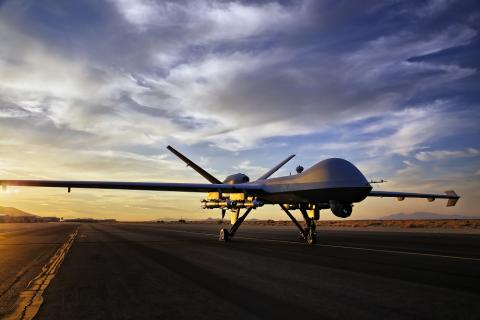AUVSI is about to give unmanned aircraft systems operators a way to increase their safety and boost their standing in a burgeoning marketplace, through the new Trusted Operator Program (TOP).
Becoming a commercial drone pilot and operating a UAS represents an exciting and rewarding career in a dynamic and emerging industry, but from a regulatory perspective, there is little required for the commercial drone operator to demonstrate competency or proficiency in his or her operations. There are training courses available to the prospective drone pilot, however, so far there has been no industry unification with respect to remote pilot competency training or testing programs.
Air
Air
Aerospace Cornwall and UAVAid to launch first UAS flight from Cornwall Airport Newquay in May 2019
Aerospace Cornwall has partnered with UK based UAS developer and operator UAVAid to launch the first UAS flight from Cornwall Airport Newquay in England during a capability event in May 2019.
During the event, UAVAid will showcase Hansard, its humanitarian UAS platform. The UAS is designed to not only “fundamentally improve the way aid agencies can respond to large scale disasters,” but also “boost healthcare and economic development in the developing world.”
Each UAS has a variety of capabilities, including long range cargo delivery, live streaming aerial video and large area mapping, in low infrastructure contexts.

Schiebel's Camcopter S-100 UAS conducts flight display during Red Bull Air Race
During the Red Bull Air Race in Wiener Neustadt, Austria, Schiebel’s Camcopter S-100 UAS conducted a flight display.
Returning to its Austrian roots for the sixth race of the season, the Red Bull Air Race partnered with Schiebel in Wiener Neustadt, which is where the Camcopter S-100 production facility is located.
“The history of our company is strongly connected to the location of Wiener Neustadt and we are excited to be partnered with Red Bull Air Race 2018,” says Hannes Hecher, CEO of Schiebel.
“This presents a wonderful opportunity to bring together unmanned and manned aviation and give the audience a taste of the expertise and vision represented by the two sectors.”

GA-ASI's new Automatic Takeoff and Landing Capability demonstrated on MQ-9 Block 5 RPA
General Atomics Aeronautical Systems Inc. (GA-ASI) has announced that the U.S. Air Force (USAF) completed the first-ever automated landing of an MQ-9 Block 5 Remotely Piloted Aircraft (RPA) on Aug. 7, which was followed a few days later by the first auto-takeoff on Aug. 9.
GA-ASI says that it developed the new Automatic Takeoff and Landing Capability (ATLC) to “enhance mission capability.”
“This new, all-weather capability greatly increases the autonomy, flexibility, combat effectiveness and safety of the MQ-9 Reaper for the USAF,” explains David R. Alexander, president, Aircraft Systems, GA-ASI.

Colorado Northwestern Community College launches new UAS program
Colorado Northwestern Community College (CNCC) is launching a new UAS program.
Scheduled to start on Oct. 15 at both the Craig and Rangely campuses, the first course, known as “AVT 160 – Introduction to Unmanned Aircraft Systems,” is described as a hybrid class taught in-person and online. According to CraigDailyPress.com, it is the first of three UAS courses the college plans to offer.
“This is a stepping stone for where we are going with the course,” says CNCC Aviation Technology Program Director David Boles.

Self-Deploying Drone Pilots may be Problem for Hurricane Response Efforts
Last year’s hurricane season was a benchmark year for the role of drones in emergency management. Harvey, Irma, and Maria all had varying characteristics that served well to showcase the benefits that unmanned aircraft systems can provide for response and recovery operations. However, the well-documented — and publicized — success of those efforts is now likely to create a new problem: well-intentioned remote pilots who self-deploy to disaster scenes hoping to help save the day.

From Unmanned Systems Magazine: U.S. Navy’s new roadmap sees vast potential for unmanned systems
The U.S. Navy sees vast potential for unmanned systems and the capabilities they will bring, according to the service’s Strategic Roadmap for Unmanned Systems.
Use of unmanned and autonomous systems will create nothing less than "fundamental shifts" in the way the Navy operates, says an unclassified summary of the roadmap released in May. Their integration, it says, will allow reductions in manpower and risk to personnel, lower operating costs, increased persistence, faster and more accurate data processing, and a faster decision cycle.

Currawong Engineering's 18S ESC Velocity for UAS applications receives updates
Currawong Engineering has released its updated 18S ESC (electronic speed controller) Velocity, which features the addition of “true hardware interlock and fully isolated PWM input” to its existing design.
Featuring high power and aerospace grade reliability, the ESC Velocity is designed for UAS applications.
According to Currawong Engineering, true hardware interlock is the “ultimate in operator safety,” as it provides guaranteed motor shutdown without the need for bulky inline power switches. CAN communications operate independently of the interlock, which allows for preflight checks with absolute confidence in the safe status of the controller.

Altiscope releases 'Blueprint for the Sky: The Roadmap for the Safe Integration of Autonomous Aircraft'
Altiscope, which is the Unmanned Traffic Management (UTM) group from A³ by Airbus, has released “Blueprint for the Sky: The Roadmap for the Safe Integration of Autonomous Aircraft.”
The Blueprint represents months of careful analysis by Airbus of the future needs for the airspace, the widespread impact of the upcoming changes to the airspace, and the development of the required tools for its enablement.



